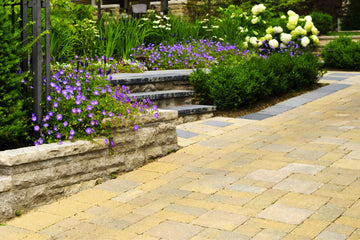The Renaissance of Luxury: How Natural Stone is Redefining Modern Opulence

In an age where artificial intelligence designs our experiences and synthetic materials dominate our surroundings, true luxury has taken an unexpected turn. The ultra-wealthy aren't flocking to the latest high-tech gadgets or manufactured marvels. Instead, they're returning to something far more precious and rare: authentic natural stone. But this isn't your grandmother's marble foyer – this is a sophisticated renaissance where ancient materials meet contemporary sensibilities, creating spaces that whisper elegance rather than shout extravagance.
The New Definition of Luxury: Authenticity Over Artifice
Walk into any billionaire's newly renovated penthouse or celebrity chef's dream kitchen, and you'll notice something striking: the absence of flashy, synthetic materials that once defined luxury. Gone are the days when luxury meant the most expensive artificial surfaces or the latest technological material innovations. Today's discerning elite understand that true luxury lies in authenticity, rarity, and the irreplaceable character that only natural stone can provide.
This shift represents more than aesthetic preference – it's a philosophical statement. In a world where everything can be manufactured, replicated, and mass-produced, owning something genuinely unique becomes the ultimate luxury. Each slab of natural stone carries patterns that will never be repeated, colors that can't be perfectly replicated, and a history that spans millennia. It's luxury with a story, prestige with purpose.
The Psychology of Opulent Spaces: Why Stone Elevates the Soul
Leading interior psychologists have discovered something fascinating about human responses to natural materials: we're hardwired to find them more appealing than synthetic alternatives. This biological preference, known as biophilia, explains why natural stone environments consistently rate higher in comfort, prestige, and emotional satisfaction surveys.
But there's more to it than instinct. Natural stone possesses what designers call "visual weight" – a quality that makes spaces feel substantial, grounded, and permanent. When you enter a room dominated by beautiful natural stone, your brain subconsciously registers the massive geological forces and time scales required to create these materials. This creates an immediate sense of gravitas and importance that synthetic materials, no matter how expertly crafted, simply cannot match.
Research from luxury hospitality groups reveals that guests consistently rate natural stone environments as more relaxing, more prestigious, and more memorable than those featuring manufactured materials. It's not just about appearance – it's about the subtle psychological signals that natural stone sends about value, permanence, and refinement.
The Art of Imperfection: Why Flaws Make Stones Priceless
In the manufactured world, perfection is the goal. Every product should match exactly, every surface should be uniform, every pattern should be predictable. Natural stone turns this concept on its head, revealing that luxury lies not in perfection but in beautiful imperfection.
The most sought-after stones are often those with the most character: the limestone with unexpected fossil inclusions, the granite with dramatic veining that tells the story of ancient geological upheavals, the sandstone with color variations that capture different moments in geological time. These "imperfections" are actually signatures of authenticity – proof that the material is genuine, unique, and irreplaceable.
High-end designers now specifically seek out stones with distinctive characteristics. They're not looking for uniformity; they're hunting for personality. A kitchen island cut from a single slab of dramatically veined granite becomes a conversation piece, a work of art that happens to be functional. A bathroom clad in limestone with visible fossil impressions becomes a private natural history museum.
The Sustainability Paradox: Ancient Materials for Future Consciousness
Modern luxury consumers face a unique challenge: they want beautiful, prestigious materials, but they also want to make environmentally conscious choices. Natural stone presents an elegant solution to this dilemma. These materials are essentially pre-made by geological processes that occurred over millions of years, requiring no energy-intensive manufacturing processes.
The sustainability story of natural stone extends far beyond its creation. A properly installed natural stone floor, countertop, or wall covering can last for centuries with minimal maintenance. Compare this to synthetic alternatives that may need replacement every 10-20 years, and the environmental equation becomes clear: natural stone isn't just more beautiful – it's more responsible.
Furthermore, when natural stone eventually reaches end-of-life (which may be several generations away), it doesn't create toxic waste. It simply returns to the earth, often finding new life in landscaping applications or as aggregate in construction projects.
Global Inspiration: Stone Traditions Shaping Contemporary Design
The renaissance of luxury stone design draws inspiration from diverse cultural traditions worldwide. Italian marble craftsmanship meets Indian sandstone artistry. Japanese stone garden principles influence modern minimalist applications. French limestone traditions inspire contemporary château-style kitchens.
This global fusion has created exciting new applications: Indian limestone traditionally used in temple construction now graces modern spa bathrooms. Rajasthani sandstone once reserved for palace courtyards now creates stunning contemporary fireplaces. Ancient Chinese granite cutting techniques inspire ultra-modern kitchen islands that seem to float despite their massive weight.
The most sophisticated designers understand that luxury isn't about imposing a single aesthetic vision – it's about weaving together the best traditions from around the world to create spaces that feel both timeless and contemporary.
The Craft Revolution: Artisans in the Digital Age
As digital fabrication techniques advance, there's been an unexpected revival in traditional stone craftsmanship. The most luxurious projects now feature hand-selected stones, custom cutting, and artisanal finishing techniques that can't be replicated by machines.
Master stonemasons, once thought to be a dying breed, are experiencing unprecedented demand. Their ability to read stone grain, understand structural properties, and execute complex installations makes them invaluable partners in luxury projects. The finest stone applications require not just technical precision but artistic sensitivity – the ability to see possibilities in raw stone that others might miss.
This human element adds another layer of luxury: the knowledge that skilled artisans have touched every surface, that human creativity and expertise have guided every cut and placement. It's the antithesis of mass production – it's mass customization at its most refined.
Color Stories: The Emotional Language of Stone
Different stones speak different emotional languages, and luxury designers are becoming increasingly sophisticated in their use of stone's psychological properties. Cool-toned limestone creates spaces that feel serene and spa-like. Warm-toned sandstone generates feelings of comfort and welcome. Dramatic black granite conveys power and sophistication. Creamy travertine suggests timeless elegance and refinement.
The most successful luxury spaces don't just use stone – they compose with it, creating emotional journeys that unfold as inhabitants move through different areas. A foyer might feature commanding dark granite that establishes immediate prestige, flowing into a kitchen with warm limestone that encourages gathering and comfort, leading to a bathroom with serene white marble that promotes relaxation and rejuvenation.
Technology Meets Tradition: The Future of Stone Luxury
Advanced technology is revolutionizing how we select, cut, and install natural stone without diminishing its essential character. 3D scanning allows designers to preview exactly how book-matched slabs will look when installed. Digital templating ensures perfect fits while minimizing waste. Specialized lifting equipment allows for the installation of massive stone elements that would have been impossible just decades ago.
But technology serves tradition rather than replacing it. The goal isn't to make stone more artificial – it's to make the installation of authentic stone more precise, more beautiful, and more sustainable.
Investment Grade Beauty: Stone as Portfolio Diversification
Savvy luxury consumers increasingly view high-quality natural stone installations as investments rather than mere decoration. Premium stone applications consistently add significant value to properties, often returning more than their initial cost when properties are sold. Unlike other luxury materials that may go out of style, natural stone's timeless appeal ensures lasting value.
Real estate professionals report that homes featuring quality natural stone applications sell faster and for higher prices than those with synthetic alternatives. The stone signals to potential buyers that the property was built with quality and attention to detail throughout.
For those seeking to embrace this renaissance of natural luxury, partnering with knowledgeable stone specialists becomes essential. Vardman Industries, with their extensive expertise in limestone, sandstone, granite, and premium stone applications, offers the deep understanding of materials and craftsmanship traditions necessary to create truly exceptional spaces – where ancient beauty meets contemporary sophistication, and where every surface tells a story of timeless elegance.







